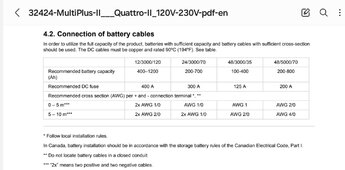I am replacing my 12v Renogy 2000 watt inverter with a 3000 watt 12 volt inverter. I used 2 gauge wire on the first one, and have ordered 1/0 AWG for the 3k inverter. 12” long to the fuse, and 12” long to the battery to the blue sea on off. Think it should be good. I am concerned about the vendor supplied cables. I heard they may be two 4 gage, and saw a few videos where people replaced them. Has anyone experienced this, or have this inverter? Thanks! (The batter bank is 760ah) if it matters!
Renogy 3000w inverter Battery Cables
- Thread starter Spartaqus
- Start date




